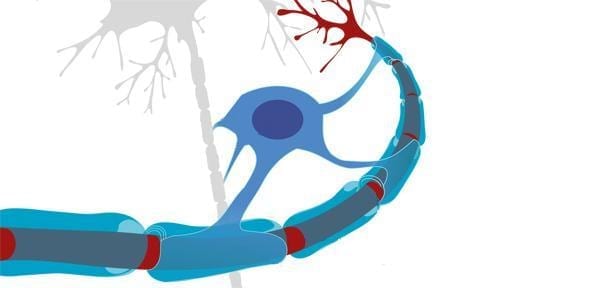
Finding could have implications for other autoimmune disorders, such as type I diabetes
Scientists from the Gladstone Institutes have discovered a way to prevent the development of multiple sclerosis (MS) in mice. Using a drug that blocks the production of a certain type of immune cell linked to inflammation and autoimmunity, the researchers successfully protected against the onset of MS in an animal model of the disease. The scientists say the next step is to test this strategy using other autoimmune disorders.
“We are very excited about these findings,” says Eric Verdin, MD, a senior investigator at Gladstone and co-senior author on the study. “In light of the significant effect the treatment had on inflammation, the implications of these results will likely extend beyond multiple sclerosis to other types of autoimmune disorders. We are particularly interested in testing this in type I diabetes given the similar pathways involved, and we are already seeing very promising results in preliminary experiments.”
In the immune system, two kinds of T cells strike a delicate balance–T helper cells (Th17) activate the immune system, protecting against infections and cancers, while regulatory T cells (Tregs) suppress the system, keeping it in check. A disparity between these cell types, where there are too many Th17 and not enough Tregs, can lead to a hyperactive immune system, resulting in inflammation, tissue damage, and autoimmune disease.
In the current study, published in the Journal of Experimental Medicine, the researchers discovered that an important regulatory protein, sirtuin 1 (SIRT1), is involved in the production of Th17 cells. By blocking this protein, the scientists can protect against the onset of autoimmunity. SIRT1 also has a negative impact on Treg maturation and maintenance, so inhibiting its expression simultaneously enhances the production of Tregs and suppresses the creation of Th17.
To test this effect on disease, the researchers used a mouse model of MS and treated the animals with a drug that inhibits SIRT1. Typically, MS-model mice experience severe motor problems, eventually leading to paralysis, but when they were given the drug the mice behaved perfectly normally. Moreover, the treated animals showed no signs of inflammation or cell damage in their spines, classic markers for MS.
Read more: Gladstone scientists discover potential new treatment for multiple sclerosis
The Latest on: Inflammation and autoimmunity
[google_news title=”” keyword=”Inflammation and autoimmunity” num_posts=”10″ blurb_length=”0″ show_thumb=”left”]
via Google News
The Latest on: Inflammation and autoimmunity
- Woman Suffered From Recurrent Episodes Of Autoimmune Encephalitis: Find Out What Docs Didon April 30, 2024 at 2:37 am
Autoimmune encephalitis is a 'collection of related conditions in which the body’s immune system attacks the brain, causing inflammation'. The immune system produces substances called 'antibodies' ...
- HanAll Biopharma Reports Q1 2024 Financial Results and Provides Business Updateon April 29, 2024 at 9:01 pm
Additionally, initial data readouts from batoclimab Phase 2b study in Chronic inflammatory demyelinating polyneuropathy ... FcRn with the potential to address multiple IgG-mediated autoimmune diseases ...
- GRI Bio Announces Abstracts Accepted for Presentation at the 14th International Congress on Autoimmunityon April 29, 2024 at 5:45 am
LA JOLLA, CA, April 29, 2024 (GLOBE NEWSWIRE) -- (NASDAQ: GRI) (“GRI Bio” or the “Company”), a biotechnology company advancing an innovative pipeline of Natural Killer T (NKT) cell modulators for the ...
- 5 Key Identifiers of a Happy, Healthy, Inflammation-Free Gut Microbiomeon April 26, 2024 at 7:52 am
Certain yoga poses help stimulate digestion through gentle massage, and diaphragmatic breathing during yoga can reduce stress and stimulate the digestive system." ...
- Anti-Inflammatory Use May Reduce PD Risk in Patients With Autoimmune Diseaseson April 26, 2024 at 6:33 am
Researchers examined the relationship between exposure to anti-inflammatory therapy and the incidence of Parkinson disease in patients with autoimmune conditions.
- What to Eat When You Have Lupus, According to MDs and RDson April 25, 2024 at 8:30 pm
When it comes to managing lupus symptoms, there's no set lupus diet. Here, a rheumatologist and two dietitians share which foods to generally eat or avoid.
- Fever, swollen glands, fatigue, rash and joint pain? Know how to identify autoimmune diseaseson April 25, 2024 at 6:45 pm
What complicates matters is that symptoms may overlap with other diseases and triggers may be unknown, says internal medicine expert Dr Suranjit Chatterjee ...
- Best Supplements for Pain and Inflammationon April 23, 2024 at 9:23 am
Whether you’re an active individual looking for sore muscle relief after a strenuous workout, an older adult fighting arthritis discomfort, or a middle-aged person fighting the ebbs and flows of the ...
- Scientists discover the cellular functions of a family of proteins integral to inflammatory diseaseson April 22, 2024 at 12:00 pm
In a scientific breakthrough, Mount Sinai researchers have revealed the biological mechanisms by which a family of proteins known as histone deacetylases (HDACs) activate immune system cells linked to ...
- Does the Anti-Inflammatory Diet for Psoriasis Help Manage Symptoms?on April 22, 2024 at 5:51 am
Inflammation is one of the underlying causes of psoriasis, and research shows that an anti-inflammatory diet can help prevent flare-ups. Here's what you need to know.
via Bing News










